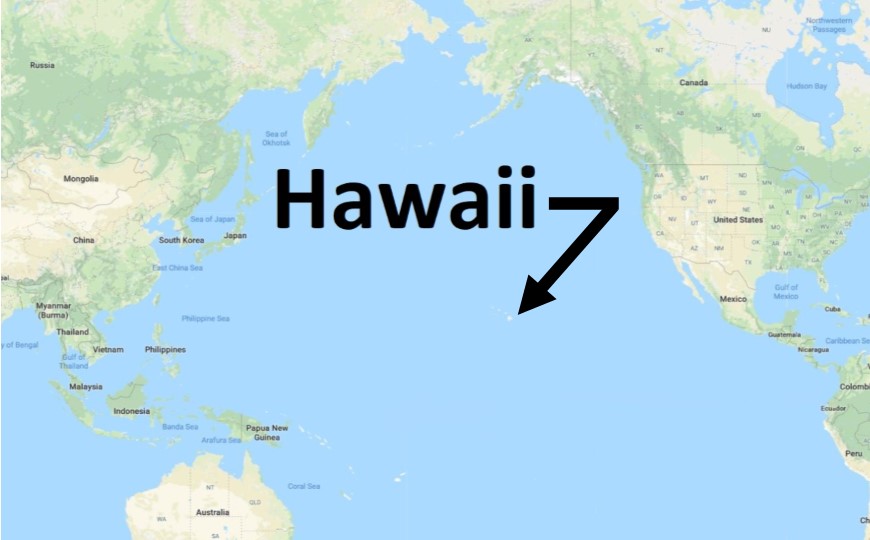
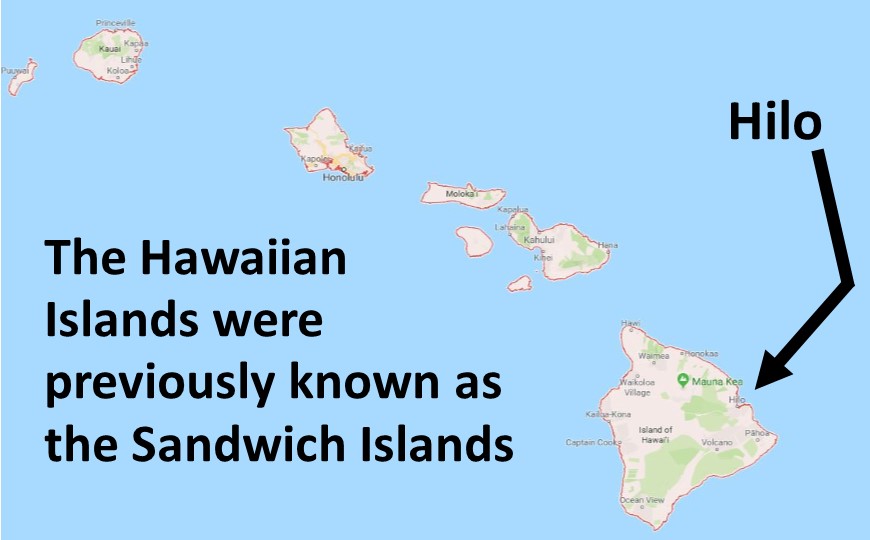
The Hawaiian Revival was prominent around Hilo, but it affected all of the islands found in the archipelago.
Introduction
Titus Coan (1801–1882) was a notable missionary during the Hawaiian revival. Born in Connecticut, Coan grew up immersed in the revivals sweeping through New England. His early experiences were shaped by prominent revivalists of the time, including Asahel Nettleton, a nephew of Coan’s mother, and Charles Finney, an influential up-and-coming revivalist. Coan not only became acquainted with both men but also worked alongside Finney for a brief period.
The strategies and techniques that led to revival in New England during the early part of the 1800s are what Coan duplicated after his arrival as a missionary in Hawaii in 1835.
At that time, the Hawaiian Islands were commonly referred to as the Sandwich Islands, a name given by Captain James Cook. It wasn’t until the 1840s and beyond that the local name “Hawaii” began to gain prominence in written records.
Conditions of Hawaiians Prior to the Revival
►Utter immorality, with the institution of family life almost unknown.
►Two-thirds of the infants were killed by their parents.
►Three-fourths of the women were childless due to infanticide, and the population of the islands diminished each year by several thousand.
►The first American missionaries arrived in Hawaii in 1820. Upon arrival they had found that Tahitian Christians, who had become missionaries, had already started work on Hawaii, and had succeeded in destroying much idolatry and pagan taboos. The Tahitian missionaries were so successful that they also converted some from the royal family, enabling legislation that favored morality and education. By 1836 there were 17 churches and a sixth of the population had enrolled in mission schools.
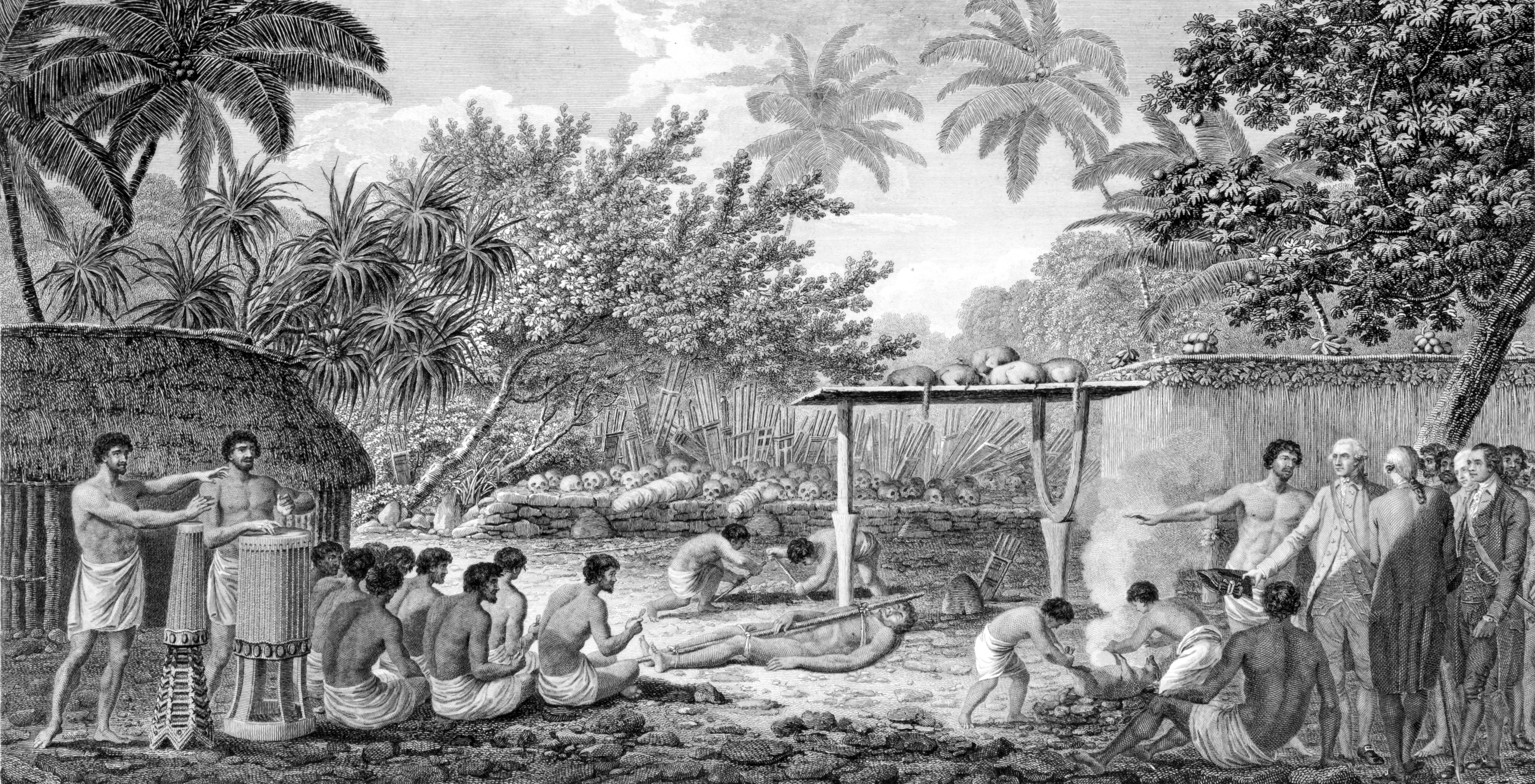
Captain James Cook witnessed human sacrifices during his visit to Polynesian islands. These sacrifices were not uncommon on Hawaii.
Extraordinary Prayer
►At the beginning of the 1830s there were only 577 church members throughout the Hawaiian Islands, but this group was anticipating a move of the Holy Spirit and the masses were developing an interest.
►The blind Hawaiian preacher, Puaaiki, known as the “Blind Preacher of Maui,” united the believers into giving themselves wholeheartedly in prayer for revival.
►On the island of Molokai, some were rising one hour before sunlight to pray for an outpouring of the Holy Spirit.
►The missionaries reported that they had never seen such “earnest, humble, persevering wrestling in prayer.” Even children were given over to prayer and were often found in the sugarcane and banana groves, weeping before God.
►A group of missionaries traveling by ship to Hawaii were praying every morning and evening, and a revival started prior to their arrival at Hawaii. One result of that revival was the ship’s captain and several others making an open commitment to Christ.
►The type of praying conducted by the Hawaiians was unique, in that it was united and verbal. Each person would pray out loud at the same time. This was unique in the 1830s, especially among missionaries from New England. Because of the unfamiliarity with this type of praying, some of the missionaries opposed it. That type of prayer has been witnessed in revivals throughout history.
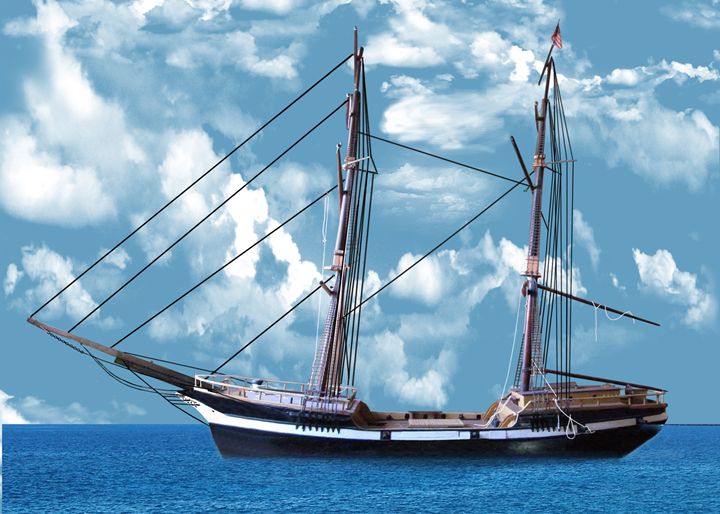
Brig Thaddeus: the ship that brought the first missionaries to Hawaii.
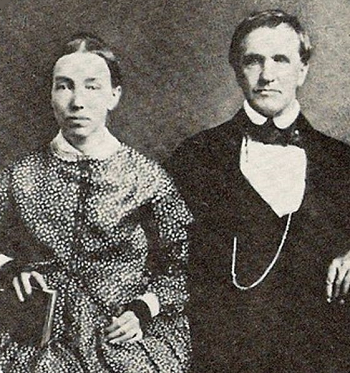
Titus & Fidelia Coan
What Happened
At age 34, Titus Coan arrived in Hawaii (June 6, 1835) to become the pastor of the Hilo Church. Having come directly from the United States, which was then experiencing a wide-spread revival, expectation for something similar was on the heart and mind of Coan and the other new arrivals.
The means used by Asahel Nettleton and Charles Finney, which ignited revivals wherever they went in New England, were the same means utilized by Coan and others on the Hawaiian Islands, and they were:
►Extraordinary prayer.
►Incarnational ministry (learning the language and culture of the people, then adapting to it).
►Protracted meetings (consecutive church services every night for days).
►Spending time counseling people individually or in small groups.
►Preaching of the Word of God.
Beginning in 1836, Coan began preaching tours 4-5 times per year, with each tour being about 30 days in length. This was to share the Gospel with every person within 100 miles from Hilo where he lived. This involved ministering to 15,000-16,000 people who inhabited that part of the island. On these preaching tours he would travel on foot over very rugged terrain. He would preach 3-5 times per day and would counsel with inquirers between sermons. During a preaching tour in the Puna area, Coan writes:
Many listened with tears, and after the preaching, when I supposed they would return to their homes and give me rest, they remained and crowded around me so earnestly, that I had no time to eat. And in places where I spent my nights they filled the house to its entire capacity, leaving scores outside who could not enter.
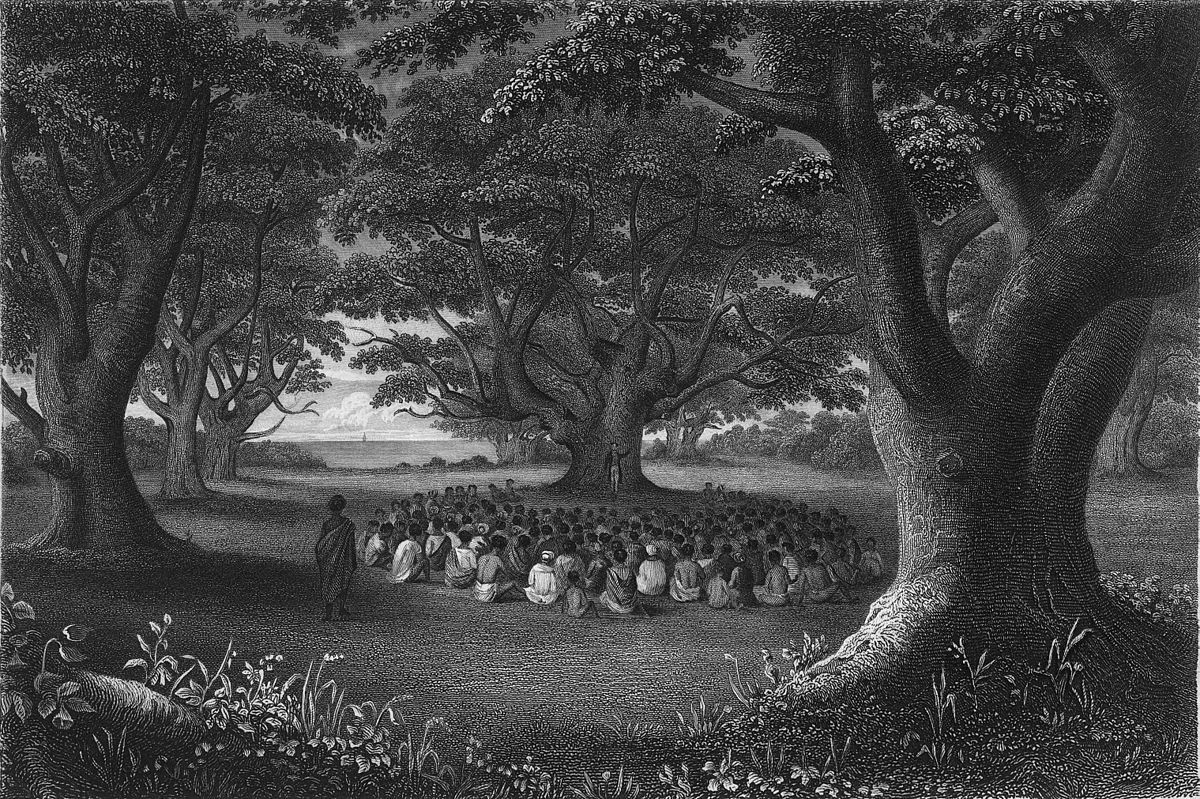
Missionaries preaching under kukui trees.
The High Priest and Priestess of Pele
At six feet five inches tall, the high priest of the volcano goddess Pele was reputed to be the fiercest and most feared individual on the island. His duty was to keep Pele appeased, and at times required human sacrifices. His sister, who had a similar reputation, and who was of similar stature, was the priestess of Pele.
As the Holy Spirit moved upon the population, this priest also wandered into the meetings and the Word of God pierced his heart. With weeping he confessed his sins and acknowledged he had been deceived by that which “was no god.” His sister, the priestess, in time also made a profession of her faith in Christ, and they both were received into church membership.
Diligent Follow-Up
Coan’s success could also be attributed to his detailed follow-up system he had in place. He not only kept the names of each new convert, he also tracked their progress toward church membership. He made personal visits to the church members on a regular basis, confirming their commitments and giving them continual encouragement in their faithfulness.
His frequent preaching tours of the region would also include him conducting a roll call at each church in a given area. If there was someone that didn’t respond to the roll call, he would inquire about that person, and either have that person sent for, or they would be visited.
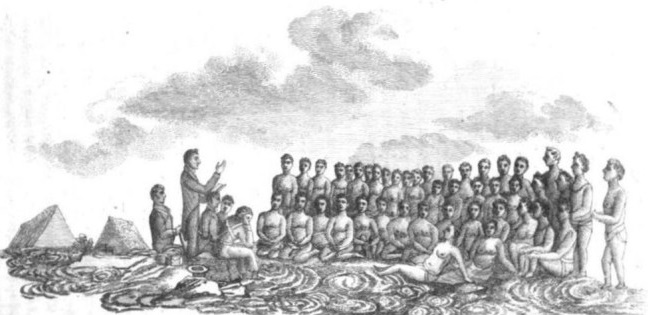
Missionary preaching to Hawaiians
Tidal Wave Brings an Even Greater Harvest
On November 7, 1837, at 7 p.m., a heavy sound was heard, like the falling of a mountain on the beach. A tidal wave had hit the coast of Hawaii. It struck everything 15-20 feet above the high-water mark. There was tremendous devastation of homes and property, with 13 lives being lost.
Because the tidal wave was so unexpected, and the devastation so complete, it awakened the Hawaiian’s consciousness to the realization that death could come unexpectedly. Following this realization, Coan commented:
Our meetings were more and more crowded, and hopeful converts were multiplied.
This renewed awakening affected more than those at the Hilo church, it also impacted congregations on other islands where the tidal wave left its mark.
Scenes of Repentance
The conviction of sin was intense. The scenes that became commonplace were typical of revivals that have occurred throughout history:
►Public confession of sin.
►Great joy upon deliverance from sins.
►Missionaries didn’t know what to do with the emotional impact the Holy Spirit was making upon people being convicted. People would often call out with phrases like:
Lord, have mercy on me; I am dead in sin.
There’s a two-edged sword cutting me to pieces; my flesh is all flying in the air!
God has struck me.
What shall I do to be saved?
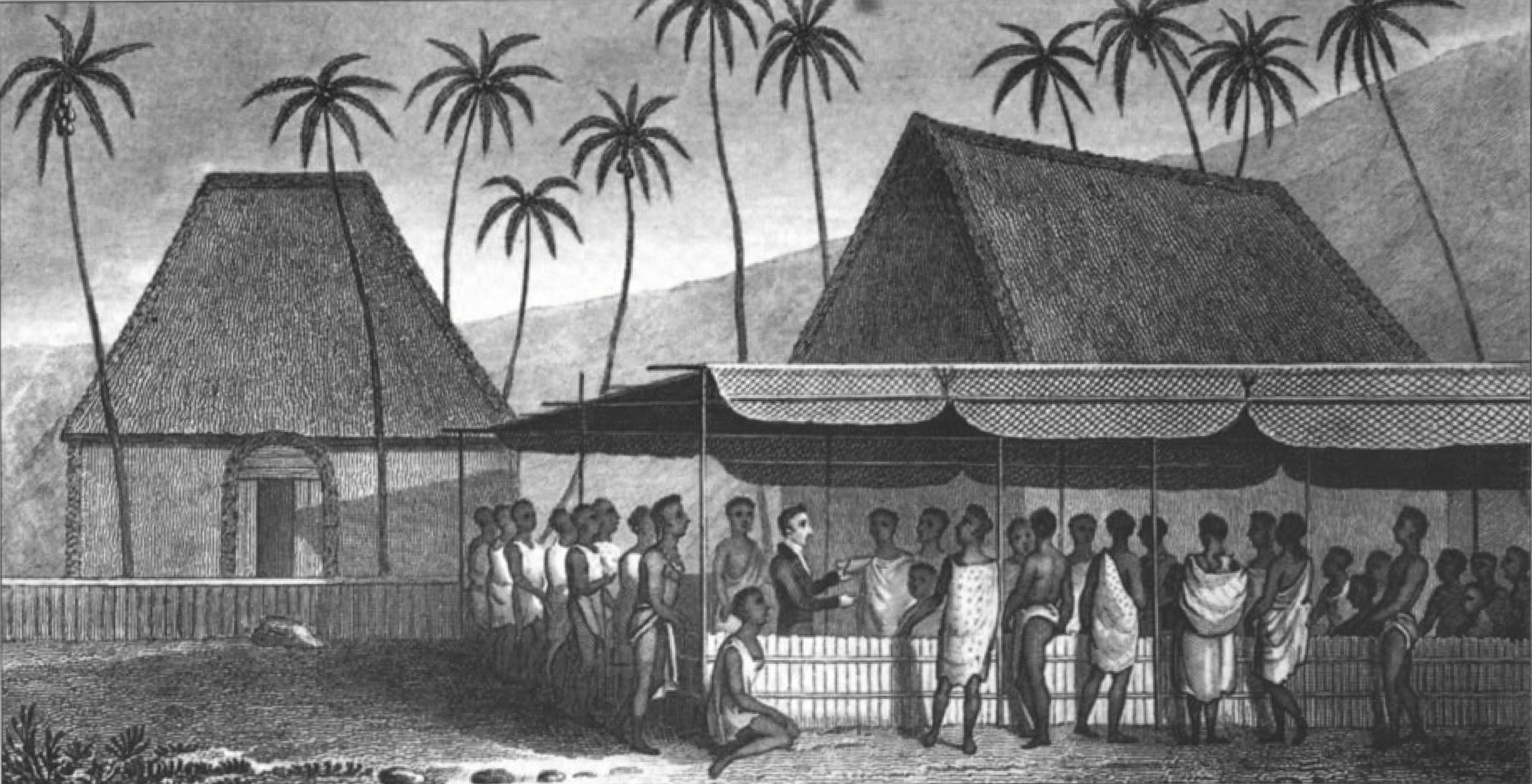
Missionary preaching to Hawaiians
►There were individuals who would begin to tremble and fall helpless to the floor.
►In the Puna area of the island, Coan reported this physical demonstration:
A very large concourse were seated on the grass, and I was standing in the center preaching… Of a sudden, a man who had been gazing with intense interest at the preacher, burst out in a fervent prayer, with streaming tears, saying: “Lord, have mercy on me; I am dead in sin.” His weeping was so loud, and his trembling so great, that the whole congregation was moved as by a common sympathy. Many wept aloud, and many commenced praying together. The scene was such as I had never before witnessed. I stood dumb in the midst of this weeping, wailing, praying multitude, not being able to make myself heard for about twenty minutes.
►On one occasion, after the huge congregation had gathered, Coan reported that he
would rise before the restless, noisy crowd and begin [preaching]. It wasn’t long before I felt that I had got hold of them. There seemed to be a chord of electricity binding them to me. I knew that I had them, that they would not go away. The Spirit would hush them by the truth till they would sob and cry, What shall we do? and the noise of the weeping would be so great that I could not go on.
►A typical pattern in most of the meetings was loud crying, shrieks, wailing, and falling down unconscious. Children were affected along with the adults.
►During the preaching of the Word of God, people would feel God’s power so strongly that their muscles would quiver. It became so intense that Coan would describe some of the scenes as an “earthquake shock”. He also commented by saying that as people would fall under that power, they would lay “groaning on the ground for fifteen minutes or half an hour…”
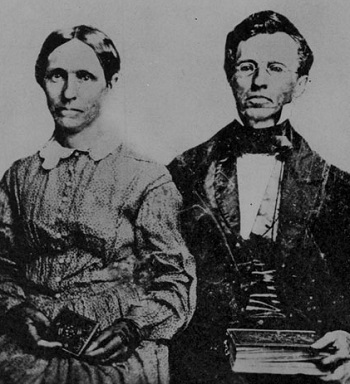
Lorenzo & Lucia Lyons
Missionaries who served on the
north half of the island of Hawaii.
As in every revival where these scenes of deep conviction and repentance were carried out, Coan and a fellow missionary, Lorenzo Lyons, were criticized by other missionaries for allowing such emotional outbursts. Coan’s reply was that the shaking, weeping, trembling, etc., was nothing more than a “token of the Holy Spirit”. Coan replied to his critics that he didn’t work up the emotional display that brought genuine repentance, and he wasn’t going to put it down.
Intense Love for the Word of God
►During Coan’s 1836 preaching tour around the island, people would follow him from one town to the next, just so they could hear more from the Bible. Concerning this deep hunger for the Word of God, Coan wrote the following:
There were places along the routes where there were no houses near the trail, but where a few families were living half a mile or more inland. In such places, the few dwellers would come down to the path leading their blind, and carrying their sick and aged upon their backs, and lay them down under a tree if there was one near, or upon the naked rocks, that they might hear of a Savior. It was often affecting to see those withered and trembling hands reached out to grasp the hand of the teacher, and to hear the palsied, the blind, and the lame begging him to stop awhile and tell them the story of Jesus.
►Each of the mission stations were having meetings every day. People could not get enough of God’s word.
Two-Year Camp Meeting
►By 1837 the population in the town of Hilo grew from 1,000 to 10,000, as people from distant villages built homes close to the Hilo church. This was so they could attend church and hear the preaching of the Word of God. At any hour of the day, when the bell would ring, a congregation of between 3,000 – 6,000 would gather.
►Classes for all ages were held daily in preparation for church membership and baptism.
►The Hilo church building was 85’ wide and 100’ long, much too small for the 6,000 that would gather daily, so a new church was built nearby to hold the overflow of 3,000 or more people.
►The first copy of the Hawaiian language New Testament was given to Queen Kaahumanu on her death bed in 1832. Since the Bible was available, and a large number of people had had the opportunity to learn how to read at the mission schools, the development of national Hawaiian believers was in progress, and they were utilized by Coan and others as they sent them out “two-by-two” on preaching tours.
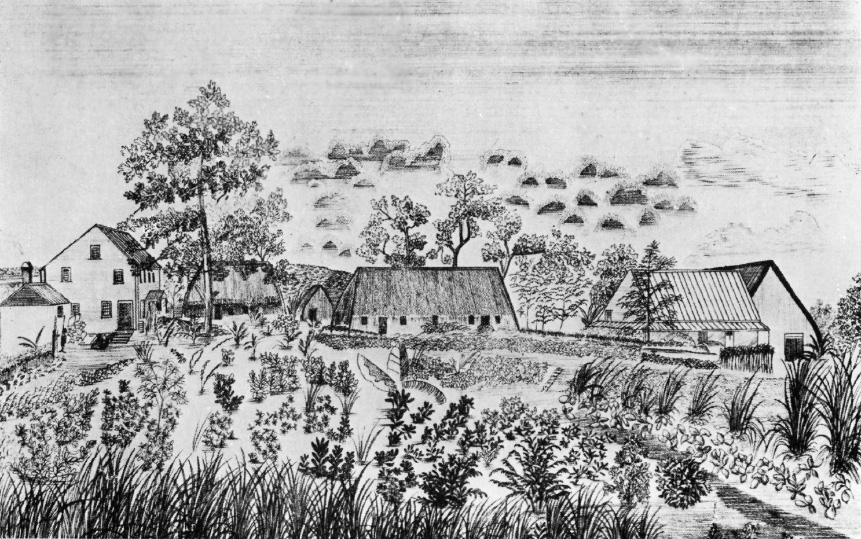
First campus of the boarding school at Hilo (1836). This school was started by David B. Lyman, the missionary who served alongside Titus Coan for almost 50 years.
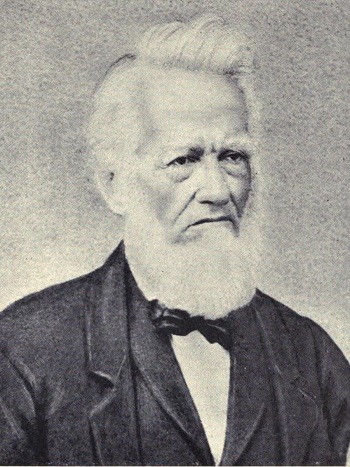
David B. Lyman served alongside
Titus Coan for almost 50 years.
Giving
►Being so completely transformed, the Hawaiians dreaded the thought of going to church without something to give. Though they were poor, they always brought something to contribute to the work of the Lord; vegetables, salt, fish, eggs, cocoanuts, birds, fire wood, etc.
►There was also the gift of time that was given, as everyone joined in when it came to constructing a church building.
►Others gave of themselves to evangelism and in bringing others to the church services.
Manifestation of Power
Those that documented the revival noted that the missionaries and others who would preach during the services were transformed while delivering their messages, and the preaching was “prophetic,” in that the words spoke had deep and intense penetrating power.
Fear of God
A deep reverence for God was formed as unusual demonstrations of power were witnessed. One example was a time when a young man came to a church service to mock and disrupt, but he was subsequently overcome by the Holy Spirit. Coan remarked about that young man by saying:
He fell as senseless as a log upon the ground and was carried out of the house. It was sometime before his consciousness would be restored. He became sober, confessed his sins, and in due time united with the church.
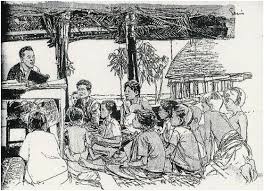
Sunday School
The Fading of the Revival
Although the majority of the Christians were holding to their profession, by 1841 a notable decline in the zeal began to be evident, and church attendance was declining. Some of the reasons explaining why the revival faded include:
►Hawaii became flooded with those from different Christian denominations, as well as cults. These elements divided and separated the unity, thus weakening the Body of Christ. ►On January 20, 1841, Coan wrote that
Eight or Ten Popish priests [Roman Catholic] are said to be already here, and fifteen more are expected soon. They will soon plant themselves at all our important posts…. their old leaven is diffusing and poisoning the minds of many.
►The population of Hawaiians dramatically declined due to epidemics of smallpox and measles.
►The increase of the sugar industry required businesses to bring foreign laborers from China and Japan. With these laborers came their religious beliefs and customs, which further weakened the remaining Hawaiian Christian population. These foreign laborers from the Orient soon became the majority, and the Christians became the minority.
►When the gold rush in California occurred, those arriving from the United States brought with them their love of money, and it saturated Hawaii. The minds of people began to turn from the concern for their souls to secular matters.
►Political changes created confusion and hardened some to the Gospel.
►There were not many that wanted to pick up the mantle of Titus Coan and make great sacrifices for Christ. The selfless sacrifices of Coan and his ministry partner, David B. Lyman, did not interest the majority of the missionary’s children who were raised on Hawaii. Many of those children turned to business and politics, to the exclusion of demonstrating their love for the Church.
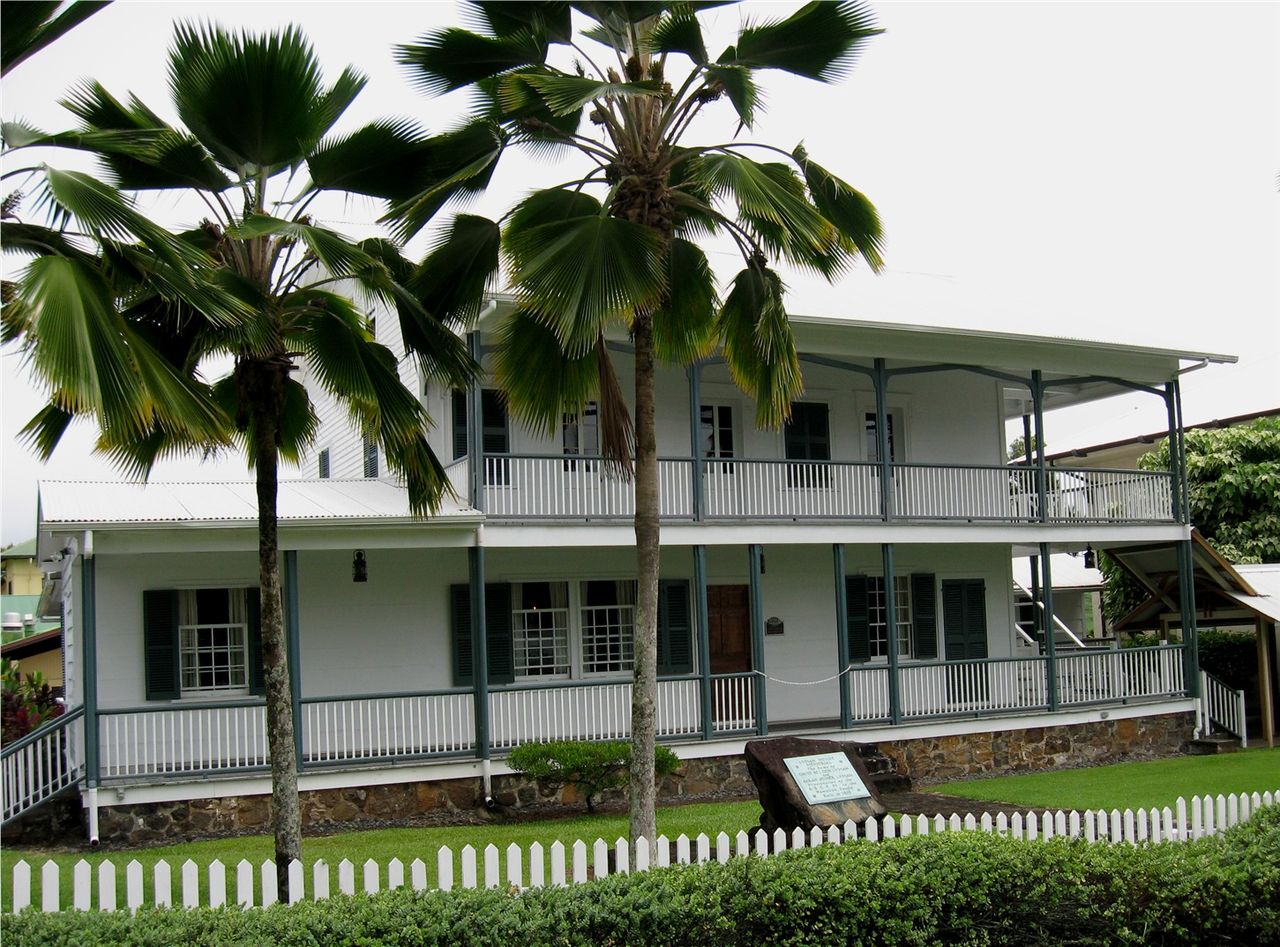
Home of David B. Lyman in Hilo. Today it is a museum.
Revival Comes Again (1860-1861)
As with every revival, there came the waning, but then in 1860-1861 there was a renewal that swept across the islands once again, with more than 1,500 being converted in 1860 and more than 800 in 1861. In addition to the conversions,
► Backslidden believers returned with renewed zeal in their commitments to Christ, and many of the young people made a profession of their faith.
►The daily prayer meetings were more intense in intercession than had ever been witnessed.
►Services were held three times per day, with evening services lasting till late in the evening.
►Evangelistic efforts were renewed.
►Laborers who had been brought in from China and Japan began to be won to Christ, especially those from the Buddhist faith.
►Public confessions were made, with pleadings for forgiveness for wrongs done to others.
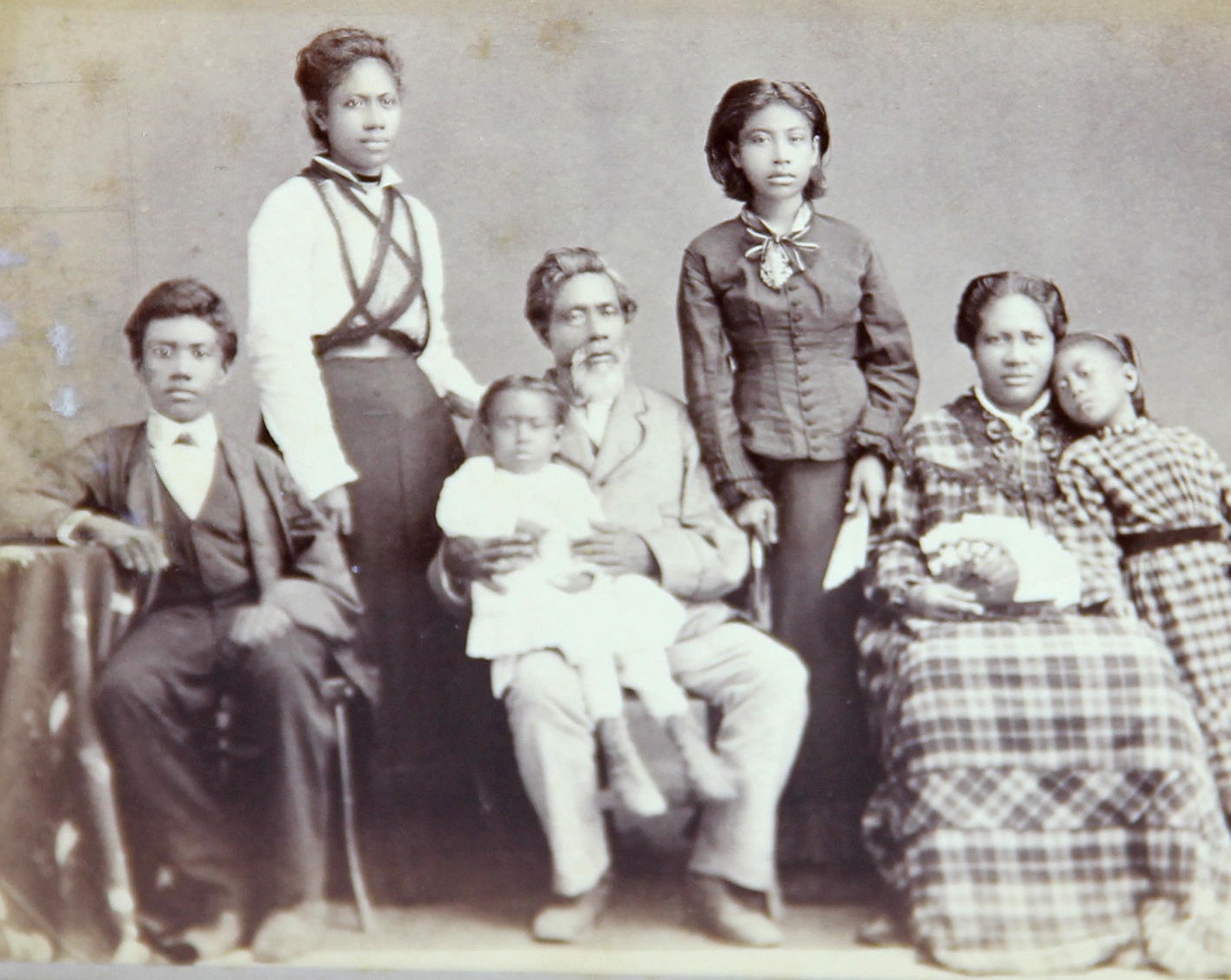
Hawaiian missionary family
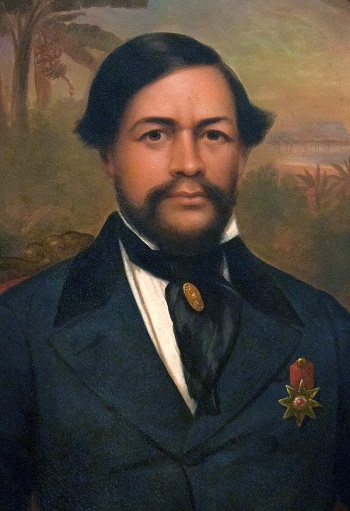
Hawaiian King Kamehameha III
Results of the Hawaiian Revival
►Quarrels were reconciled.
►Drunkards gave up alcohol.
►The lazy became diligent.
►Thousands broke their pipes and gave up tobacco.
►Thieves restored property.
►Fidelity in marriages occurred.
►Murders were confessed.
►Many stood fast in their faith, with little backsliding reported.
►From January to May, 1838, Coan received 639 people into church membership, while a missionary colleague (Lorenzo Lyons) serving on the opposite side of the island in the Waimea area, took in 2,600.
►In 1839, Coan took in 5,244 members and Lyons 2,300.
►By June 1841, 7,557 had been added to the Hilo church. That was three quarters of the population found in Coan’s area of ministry.
►Twenty years after the Great Awakening, Coan made a preaching tour on the Island of Oahu, and the result was more people being added to the church on Oahu than at any time since 1839.
►The Hawaiian Society of Foreign Missions was formed in 1850 and sent out 12 Hawaiian believers as missionaries to other Polynesian islands—fully supported by the churches they came from. King Kamehameha III sent letters along with these missionaries, encouraging the chiefs of the Pacific islands to receive the missionaries and to renounce their idols and worship the true and living God. The spirit of the Hawaiian missions movement was summed up by the veteran Hawaiian missionary, Kanwealoha on June 15, 1870, when he said,
Not with power and ball, and swords and cannon, but with the living Word of God, and with his Spirit, do we go forth to conquer the Island for Christ.
►In 1867 the Hilo church was divided into 7 congregations, with Hawaiian pastors overseeing 6 of them. One of the churches in Hilo had an American pastor, who ministered to the foreign population. To accommodate the scattered population, 15 churches were built, accommodating congregations numbering from 500 – 3,000.
►Kamehameha III, the reigning king of Hawaii, officially abolished idolatry, and though toleration was granted, the Christian faith was established with these words:
The religion of the Lord Jesus Christ shall continue to be the established religion of the Hawaiian Islands.
►The motto of Hawaii, established by Kamehameha III on July 31, 1843, is still the motto of Hawaii today:
The life of the land is perpetuated in righteousness.
Largest Church in the World at that Time
At around 70 years old (1870), prior to his departure from Hawaii on a speaking tour in the USA, Coan said he had received into the church, and had baptized, 11,960 persons, as well as baptized about 4,000 infants. The church Coan pastored had the most members of any single congregation in the world.
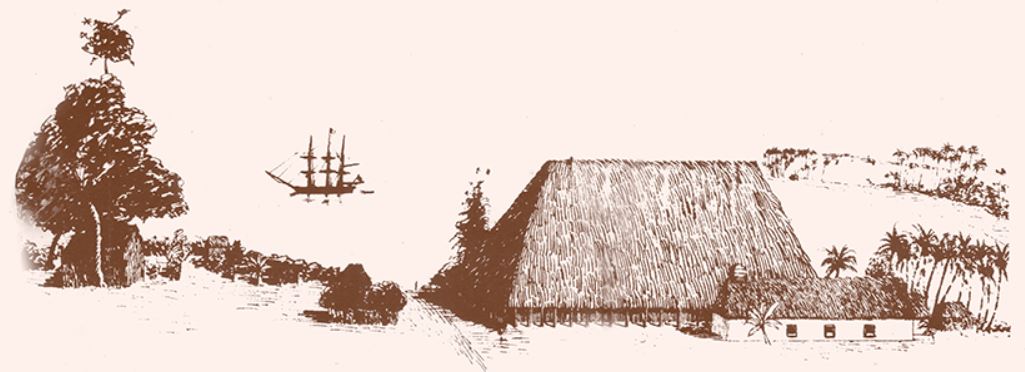
Hilo church and mission house
Sources
Adventures in Patagonia by Titus Coan
Evangelical Awakenings in the South Seas by J. Edwin Orr
Four Memorable Years at Hilo by S. J. Humphrey
Hawaii’s Great Awakening by The Gospel Truth
Hawaiian Missionaries: Labors of Love by Bill Federer
History of Haili Church website of Haili Congregational Church
History of the Sandwich Islands Mission by Rufus Anderson
Life in Hawaii by Titus Coan
Rev. Titus Coan by Find a Grave
The 10 Greatest Revivals Ever by Elmer Towns
Titus Coan: Early Missionary to Hawaii by Dan Graves
Titus Coan a Memorial by Lydia Bingham Coan
Titus Coan Obituary from The New York Times
Titus Coan by Wikipedia
The Hawaiian Archipelago by Isabella L. Bird
The New Acts of the Apostles by A. T. Pierson
Life Events of Titus Coan
• Born February 1, 1801
• Age 29 – Converted to Christ during a revival in his hometown of Killingworth, CT (1829)
• Age 29 – Met Charles Finney (summer of 1830)
• Age 30 – Entered Seminary (June 1831)
• Age 32 – Ordained (April 1833)
• Age 32 – Sailed to Patagonia (South America) on a mission for the American Board of Commissioners for Foreign Missions (August 1833)
• Age 33 – Returned to the USA and married Fidelia Church on November 3, 1834
• Age 33 – Departing from Boston on the merchant ship Hellespont, for the “Sandwich Islands,” which Hawaii was called at that time. This was the 7th group from the American Board of Commissioners for Foreign Missions (December 5, 1834).
• Age 34 – Arrived in the Sandwich Islands (June 6, 1835) to become the pastor of the Hilo Church.
• Age 59 – Visited the Marquesas Islands (1860)
• Age 66 – Visited the Marquesas Islands again (1867)
• Age 70 – Visited the USA to conduct a speaking tour, making 239 missionary addresses (1870-1871)
• Age 71 – His wife Fidella died (1872)
• Age 72 – Married Lydia Bingham (October 13, 1873)
• Age 80 – Completed his autobiography
• Age 82 – Died in Hilo, Sandwich Islands (December 1, 1882)
Return to List of Revival Stories
Chet & Phyllis Swearingen:
Office: (260) 920-8248
romans1015@outlook.com
Beautiful Feet
P.O. Box 915
Auburn, IN 46706

